Heirloom tomatoes are not bred to handle being picked while green, shipped across the country, then sold three weeks later. Instead, most of them are selected for their amazing flavor, ripe off the vine.
Heirloom tomatoes are not by default sweeter than modern hybrids. Some hybrids are incredibly sweet. The difference with heirloom tomatoes is that there is more variety to choose from. If you try out classic heirloom tomatoes, you are likely to find one that has the perfect sweetness and flavor for your taste.
Here are some of the sweeter types of heirloom tomatoes by variety.
Cherry tomato varieties are generally significantly sweeter than slicing tomatoes, but some larger tomatoes are pretty sweet.
| Cherry Tomatoes | Slicing Tomatoes |
| Isis Candy Chery | Cherokee Purple |
| German Lunchbox | Pink Jazz |
| Orange Hat | Berkeley Tie Dye Pink |
| Velvet Red | Kellogg’s Breakfast |
| White Cherry | Orange Jazz |
| Green Doctors | Pork Chop |
| Blue Cream Berries | Brandywine |
This is something I’ve researched maybe a bit too much. But I really have figured out how to grow the sweetest tomatoes around. If you want to grow the sweetest tomatoes, this article will lay it all out in easy-to-understand terms for you.
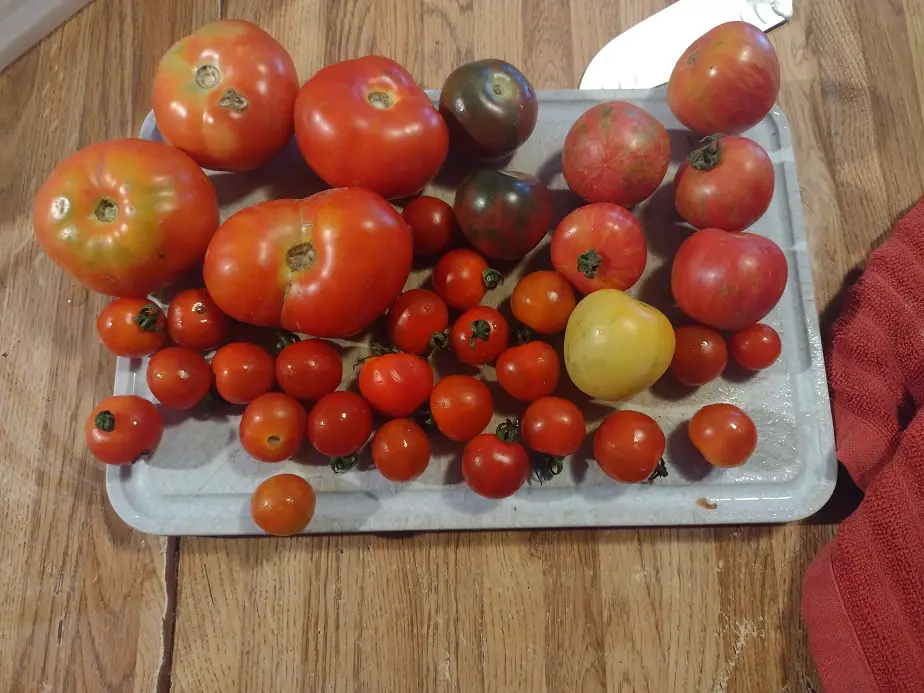
What Makes Heirloom tomatoes sweet?
Starting at the beginning, heirloom and commercial tomatoes have been bred and developed for totally different standards. The two different philosophies have developed tomatoes to fit two completely different sets of standards. The standard market tomato is a mid-sized perfectly round red tomato.
If you look at a display of tomatoes on a grocery store shelf, the tomatoes are all perfectly uniform. They are also a bit firm. Commercial slicing tomatoes are hybrids, bred to produce tough, uniformly sized fruits above all else. Many notable scientists have agreed that the traits preferred in the market tomato have a negative effect on the overall sugar content of the tomato.
On the contrary, heirloom tomatoes have no such constraints. Heirloom tomatoes are judged and selected mainly on the flavor preferred by an individual. The most commonly desired trait in heirloom tomatoes is sweetness.
Traditional tomato growers select their fruit not on how many weeks it can be stored unpreserved, but on how good it tastes right off the vine. That’s exactly how I do it too. because of that, heirloom tomatoes tend to be sweeter than standard market tomatoes.
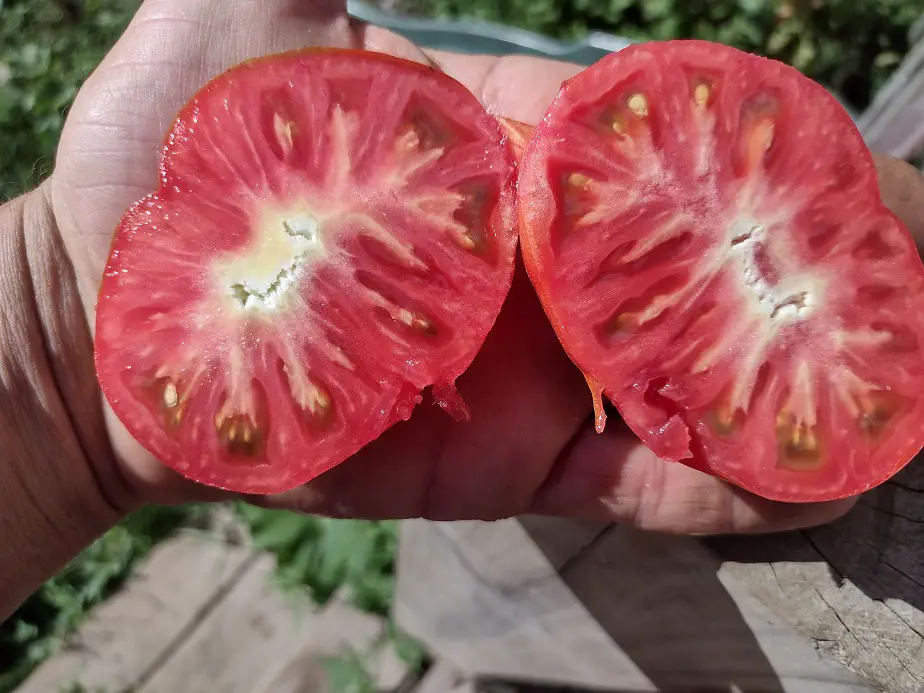
Is There Actually Sugar in Heirloom Tomatoes?
The sweet flavor of tomatoes comes mainly from fructose. That’s not surprising, considering it’s the main type of sugar in most fruits, and that a tomato is a fruit. Other sweet compounds in a tomato are the sugars glucose and galactose.
Tomatoes, cultivated varieties, and their wild predecessors, all get their sweetness from those sugars. After a tomato blossom is fertilized, the plant begins pumping it full of starches, including sucrose, until it’s nearly full size.
Sucrose is created within the leaves of the plant through part of the photosynthetic process. The sucrose is carried through the stem and deposited in the fruit.
During the ripening process, the sucrose and other starches are broken down through several metabolic processes within different parts of the cellular structure of the tomato fruit. The result is mostly fructose.
A mid-sized heirloom tomato has approximately 50 percent higher sugar content than most store-bought slicing tomatoes. That’s a big difference. The different selection of traits, and the different growing techniques used by traditional growers make for a significantly sweeter tomato.
The amount of sugar in a tomato is measured in TSS (Total Soluble Solids) the more common term for this is BRIX. It’s not a measurement of just sugar content, but of all the water-soluble compounds in the fruit. It ends up being a fairly accurate way to measure the sugar content because as the TSS increases, the sugar content increases on nearly the same scale.
If you are really interested, there is a neat tool that will measure the BRIX in your tomatoes. The BRIX refractometer is a cheap piece of equipment. There are good ones on Amazon for around twenty dollars. I’m buying myself one for my birthday this year.
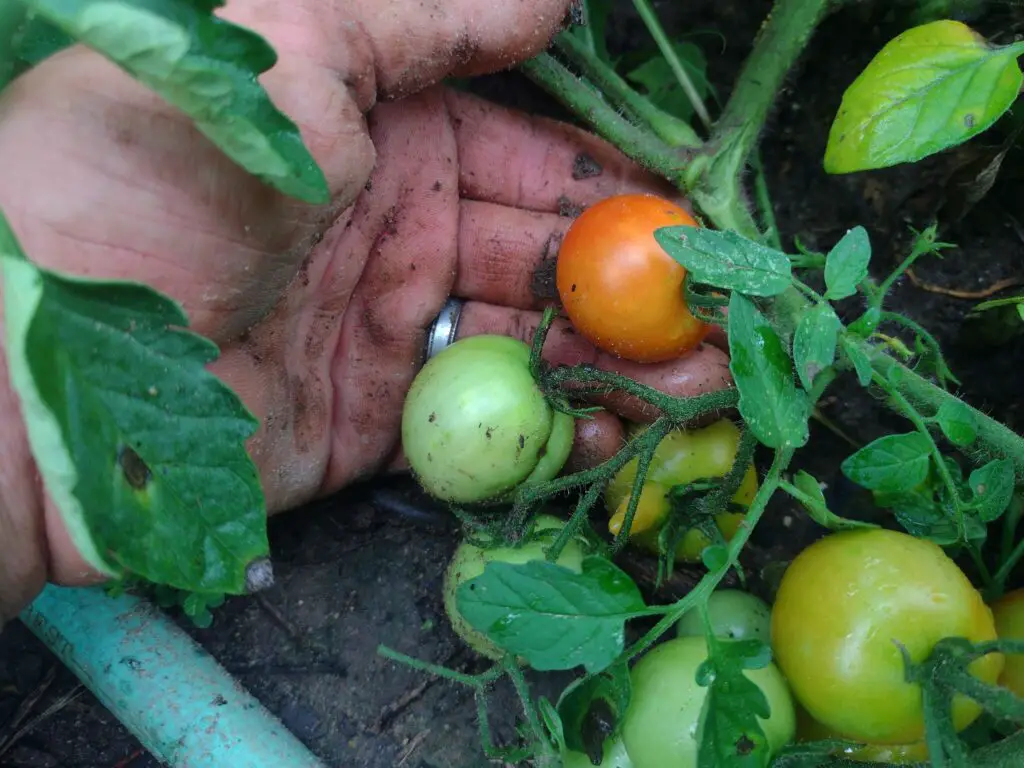
How Sweet are Heirloom Tomatoes?
The average market variety of slicing-type tomato has a TSS, or BRIX, of between 4 and 5. That’s not spectacularly sweet. With heirloom tomatoes, since they are selected more for flavor than uniformity and storage, most come in sweeter than that.
For heirloom tomatoes, the average variance seems to be closer to between 6 and 7 BRIX. That’s not going to taste like a piece of candy, but it’s definitely getting fruitier at that point. When a tomato measures a BRIX of 8, it is said to be quite fruity sweet.
A sweet slicing tomato is usually around 7 or 8 Brix, but the Brandywine tomato is often as high as 14 BRIX. Cherry tomatoes are generally between 10 and 15 BRIX. The highest don’t seem to go over 15.
The sweetness factor really depends on the individual doing the tasting. The mix of compounds can come across in different flavors to different people. However, there are a few things to look for when searching for a truly sweet variety of Heirloom tomatoes.
A tomato that is low acid generally tastes sweeter, regardless of if it actually has more sugar. A low acid content gives the fruit a smoother sweet flavor with less of a bitter bite to it.
Are All Heirloom Tomatoes Sweet?
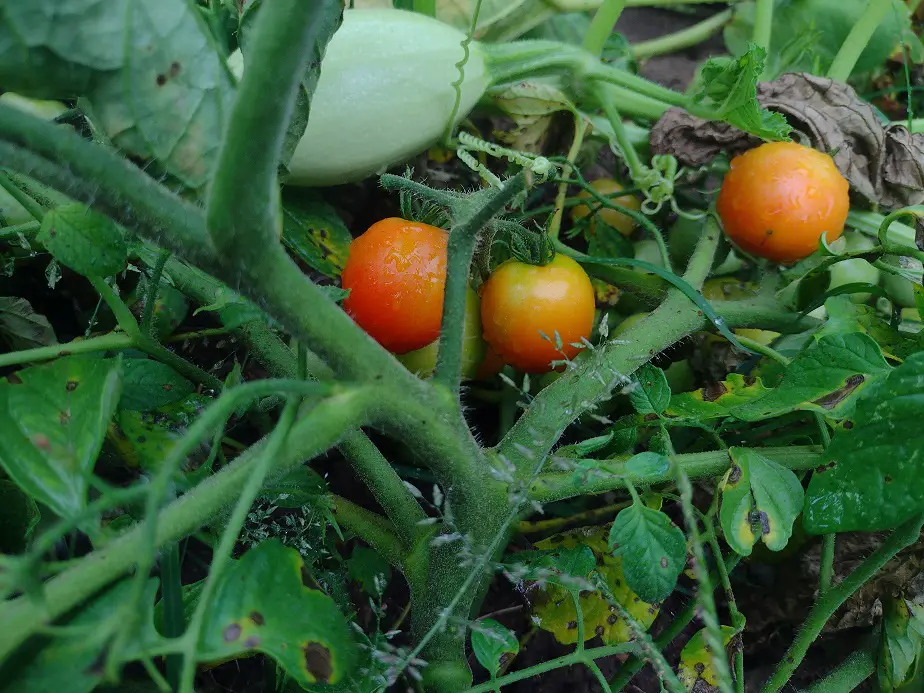
Not all heirloom tomatoes are grown for their deep sweetness. There are a lot of different taste buds out there and some prefer a more acidic tomato. There are some heirloom tomatoes grown for a more citrusy of acidic flavor. I will admit, I think they are delicious either way.
Many of the classic Italian paste-type tomatoes are on the acidic side. It’s the classic Italian flavor I suppose. That’s probably why most Italian spaghetti sauce recipes call for adding a little bit of sugar. Or, you could just start with a sweeter tomato.
Heirloom Tomato Sweetness by Color
There does seem to be a basic correlation of flavor to the different colors of Heirloom tomatoes. Did you not know tomatoes come in different colors? Heirloom tomatoes come in shades of greens, yellows, oranges, pinks, reds, purples, and in blotched and striped patterns.
- Green varieties of heirloom tomatoes are known for their tart, citrusy flavor, and are a little low on sweetness. I attribute that to the chlorophyll that’s in these tomatoes even after fully ripening.
- Yellow tomatoes often have more of a smooth, fruity flavor. They tend to be low-acid and high-flavor. Many experienced old-time tomato growers will say that the yellow tomatoes tend to taste the sweetest and fruitiest.
- Orange tomatoes are also known for a somewhat smooth, fruity flavor. Though, somewhat more balanced with acid than the yellow varieties.
- Purple tomatoes have a classic, dark taste. It’s more of a full and deep flavor, still often with a high sweetness factor.
- Red tomatoes have more of a classic, well-balanced sweet and acidic flavor. Though some are incredibly smooth and sweet too.
- Pink tomatoes are a milder version of the classic red flavor. Less acidic, and a little more sugary. In fact, one of the sweetest tomatoes is in the pink variety.
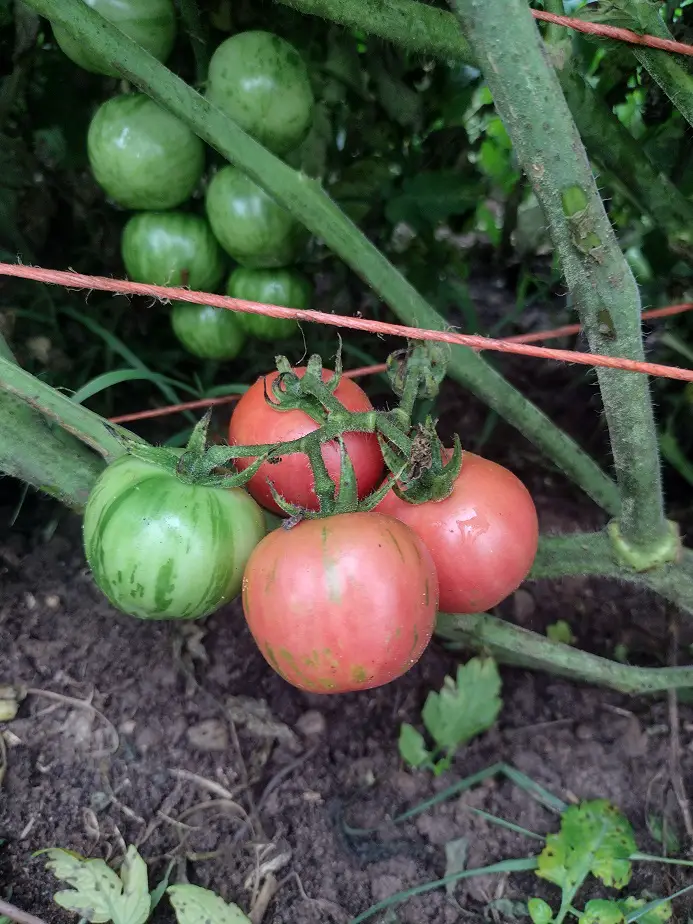
How to Grow Sweeter Heirloom Tomatoes
The single largest factor in the sweetness and sugar content of tomatoes is the tomato plant’s genes. You can’t take a non-sweet tomato and make it sweet with magic growing techniques. If you want to harvest sweet tomatoes, start with a sweet variety.
Around 80 percent of a tomato’s sugar content is solely dependent on genetic traits.
Foliage size is another influencing trait. The sweetness starts out as starches being made during part of the photosynthesis proses in the leaves of the plant. The more leaves, the more starches to turn into sugars. Plants with larger and more leaves will produce more sugar.
The size of the fruit is yet another factor in the sweetness level. As a tiny ripened tomato grows, it will increase in size ten times or more. The first part of the growth is from the division and multiplication of cells within the fruit.
The second part of growth is the growing, or swelling of the cells. As they grow, they take on more water, which has a diluting factor on the sugar content. Tomatoes that have a shorter time of the second growth will be sweeter. This is purely genetic, but I can force similar results.
By reducing water as the tomatoes begin to show their first bit of color change, the tomato fruits will swell less and have a more concentrated flavor. But they will be a tad on the small side. If you were watering heavily, try cutting back 50 percent. If you were already being stingy with the water, you probably don’t want to cut back much.
The amount of sunlight the plants get is a big factor in your control. It’s tempting to plant tomatoes where they will get a little shade so they don’t dry out. But that will hinder their sweetness. Remember that sugar production in tomatoes is a direct result of the photosynthesis that takes place.
Maximizing sun will maximize the photosynthesis potential in the foliage, which makes sweeter tomatoes. Finding the sunniest spot you absolutely can help guarantee that your tomatoes will be as sweet as possible. Don’t settle for a partially shaded spot if you have a better, more full sun location to use.
A strong root system takes up more nutrients and helps to maximize the foliage of the plant, which is good for sugar production. Keeping the nutrients moving in the plant is crucial to keep up growth and photosynthesis.
Having soft, loosely tilled soil will go a long way to improving the root system, and thus improving every aspect of the plant. Break up clay, and dilute it with organic matter to create the fluffiest soil you can imagine. Fluffy soil is crucial to a deep and spreading root system
Rocky soil also inhibits the root system. Every time s root encounters a rock or stone, the roots have to grow around it, wasting energy. Stoney or gravely soil will severely inhibit the width and depth of the root system. In my experience, by as much as 75 percent. If you have rocks in your garden soil, take time to pick them out from where you will plant your tomatoes.
The understanding of non-genotype influences on the sweetness of a tomato is both a science and an art. It’s a highly complex chemical and biological process. Still, most of it really is incredibly simple to influence, even for the beginner.
Here are some myths and other truly silly things touted to supposedly make your tomatoes sweeter. None of these really work, and some of them will just hurt your plants.
“Put a cup of sugar in the hole before you plant your tomatoes.” (don’t really do that)
I’m not kidding, I have had people swear by it, claiming that their grandmother used to do it and it made her tomatoes sweeter. The old idea was that the sugar would be taken up by the roots and the fruit would get more sugar. Except that roots won’t take in sugar.
A newer version of this idea is that sugar is food for microorganisms that will end up breaking down the organic matter in the soil at a faster rate, thereby releasing more nutrients for the plant. My response to that is a question: “If I double the fertilizer in the soil, will it grow better plants?”
The obvious answer is probably not. Not unless the soil was under-fertilized to start with. A better answer comes from an understanding of what is in sugar. Think about what plants need. Nitrogen, Phosphorus, and Potassium, mainly. Add iron, magnesium, calcium, and a few other trace minerals.
Now when I look at the label on my bag of sugar, it has none of those. Even poor gardening soil is more fertile than sugar. By adding sugar to your soil, you are in literally watering down your soil. You’d be much better off adding nothing.
“Putting a teaspoon of baking soda in your soil will lessen the acidity of the soil, which will lessen the acidity of your tomatoes, making them taste sweeter.“
This only helps if you are trying to balance out a soil that’s low in calcium.
Now, there is something to this one, but nothing like any of the people who do it try and explain it to me. Baking soda is calcium and carbon. Almost every time, a bit of extra calcium will help tomatoes grow into a stronger, more healthy plant. Healthy plants make more sugar. You can have the same effect by applying crushed eggshells, and they are organic.
“Cooling your tomatoes will lessen the stress on the plants and make them sweeter”.
I heard this just a few days ago from a frustrated gardener. She put up a canopy to give them more shade and misted them with cool water several times a day to reduce heat stress. If plants are suffering from severe heat stress, then I’d recommend it.
The sucrose is made through photosynthesis, and she blocked that from happening with shade. The mechanisms that convert the sucrose to fructose and glucose and store it within the fruit are primarily heat-driven. Temperatures above 85 degrees Fahrenheit will increase the conversion and storage of sugars in the fruit.
Honestly, those are the tips you will probably find first if you search how to get sweeter tomatoes. These so-called tips are in every forum online and have been written in many blogs by writers who don’t know gardening or how to research a topic. Too bad they’re not quite true.
There are some simple things you can do that actually have a positive effect on the increase of sugar content in tomatoes. Some of them I mentioned earlier, but I’ll touch on them again.
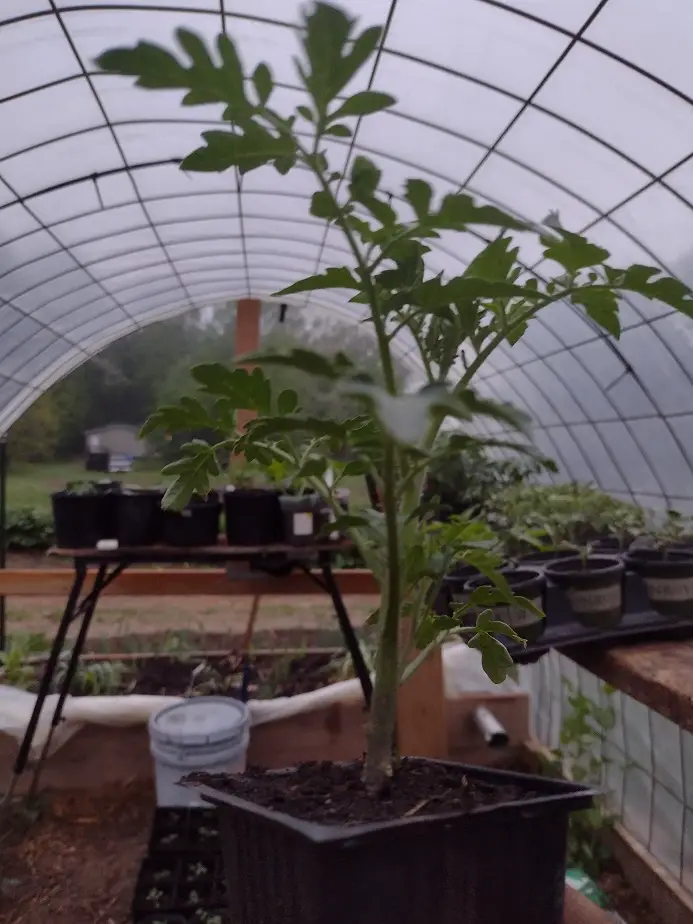
Grow the strongest healthiest plant you can
The strongest plant will have the most sugar possible for that specific variety. Add organic matter to your soil. Try and get to the magic point of 4 or 5 percent organic content in your soil. At that point, your soil will be unbelievably fluffy and will have a constant state of fertility throughout the growing season.
Add some calcium if you think your soul might be a bit low. Remove rocks, and till the soil deeply before planting. Plant your tomatoes in super full sun, they love the heat.
Limit the water they get when you see the first signs of color change.
Don’t let them dry up completely, but remember that tomatoes love the heat. It’s aright if the leaves have some curl to them during this stage. If they show severe wilt or appear too dry, water them.
Heavy water or rainfall will cause the plants to put extra water in the fruits and lessen the sugar content. You will have smaller but sweeter tomatoes.
Quite often, the first batch of tomatoes on the vine isn’t the sweetest. The higher rainfall of spring and the cooler temperatures will keep sugar content down. Where I am at, my tomatoes are the sweetest in August. That’s the hottest month with the least rain in my area of Michigan. By September, the rains come back heavy and the temperatures back down a bit.
If you like the taste of a tomato, but really love the sweeter tomatoes, you might be interested in some of the sweet cousins to the tomato.
The tomatillo is a classic Mexican fruit used as you would a tomato. They are sweeter and more firm fleshed than tomatoes. They look like a tomato but have a papery husk on the outside of them. They are super tasty and will grow anywhere a tomato will grow. Following the lead of tomatoes, the yellow and orange varieties of tomatillos are the sweetest ones.
Ground cherries are an old-time classic across the US. More common in the heirloom gardens of the Amish, they are making their way back into main popularity. Ground cherries look a lot like the tomatillos, but smaller. In my opinion, they are sweeter too.
Ground cherries are super hardy and draught tolerant. They have a much fruitier taste than a tomato. I describe it as a pineapple/mango-ish flavor.
Litchi Tomato isn’t a true tomato. It’s a thorny bush that produces completely non-acidic tomato-like fruits with a completely sweet yet tomatoey taste. The red fruits are the size of a cherry and taste almost like a cross between an actual cherry and a tomato
Tamarillo is a super sweet, unique version of tomato. It produces thin-skinned, very juicy, seed-filled, and sweet fruits. They will grow just about anywhere you can grow a tomato, but do best in warmer climates.
Related Articles:

